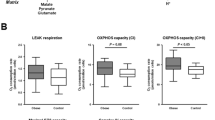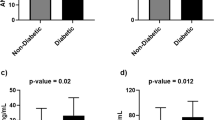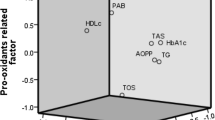Abstract
Background:
Oxidative stress and inflammation are related to obesity, but the influence of metabolic disturbances on these parameters and their relationship with endoplasmic reticulum (ER) stress is unknown. Therefore, this study was performed to evaluate whether metabolic profile influences ER and oxidative stress in an obese population with/without comorbidities.
Subjects and methods:
A total of 113 obese patients were enrolled in the study; 29 were metabolically healthy (MHO), 53 were metabolically abnormal (MAO) and 31 had type 2 diabetes (MADO). We assessed metabolic parameters, proinflammatory cytokines (TNFα and IL-6), mitochondrial and total reactive oxygen species (ROS) production, glutathione levels, antioxidant enzymes activity, total antioxidant status, mitochondrial membrane potential and ER stress marker expression levels (glucose-regulated protein (GRP78), spliced X-box binding protein 1 (XBP1), P-subunit 1 alpha (P-eIF2α) and activating transcription factor 6 (ATF6).
Results:
The MAO and MADO groups showed higher blood pressure, atherogenic dyslipidemia, insulin resistance and inflammatory profile than that of MHO subjects. Total and mitochondrial ROS production was enhanced in MAO and MADO patients, and mitochondrial membrane potential and catalase activity differed significantly between the MADO and MHO groups. In addition, decreases in glutathione levels and superoxide dismutase activity were observed in the MADO vs MAO and MHO groups. GRP78 and CHOP protein and gene expression were higher in the MAO and MADO groups with respect to MHO subjects, and sXBP1 gene expression was associated with the presence of diabetes. Furthermore, MAO patients exhibited higher levels of ATF6 than their MHO counterparts. Waist circumference was positively correlated with ATF6 and GRP78, and A1c was positively correlated with P-Eif2α. Interestingly, CHOP was positively correlated with TNFα and total ROS production and GRP78 was negatively correlated with glutathione levels.
Conclusions:
Our findings support the hypothesis that both inflammation and oxidative stress are involved in the induction of ER stress signaling pathways in the leukocytes of metabolically unhealthy obese vs healthy obese subjects.
This is a preview of subscription content, access via your institution
Access options
Subscribe to this journal
Receive 12 print issues and online access
$259.00 per year
only $21.58 per issue
Buy this article
- Purchase on Springer Link
- Instant access to full article PDF
Prices may be subject to local taxes which are calculated during checkout




Similar content being viewed by others
References
Gómez-Ambrosi J, Silva C, Galofré JC, Escalada J, Santos S, Millán D et al. Body mass index classification misses subjects with increased cardiometabolic risk factors related to elevated adiposity. Int J Obes (Lond) 2012; 36: 286–294.
Tchernof A, Després JP . Pathophysiology of human visceral obesity: an update. Physiol Rev 2013; 93: 359–404.
Stefan N, Häring HU, Hu FB, Schulze MB . Metabolically healthy obesity: epidemiology, mechanisms, and clinical implications. Lancet Diabetes Endocrinol 2013; 1: 152–162.
Primeau V, Coderre L, Karelis AD, Brochu M, Lavoie ME, Messier V et al. Characterizing the profile of obese patients who are metabolically healthy. Int J Obes (Lond) 2011; 35: 971–981.
Karelis AD, Faraj M, Bastard JP, St-Pierre DH, Brochu M, Prud'homme D et al. The metabolically healthy but obese individual presents a favorable inflammation profile. J Clin Endocrinol Metab 2005; 90: 4145–4150.
Moreno-Indias I, Oliva-Olivera W, Omiste A, Castellano-Castillo D, Lhamyani S, Camargo A et al. Adipose tissue infiltration in normal-weight subjects and its impact on metabolic function. Transl Res 2016; 172: e3.
Yin X, Lanza IR, Swain JM, Sarr MG, Nair KS, Jensen MD . Adipocyte mitochondrial function is reduced in human obesity independent of fat cell size. J Clin Endocrinol Metab 2014; 99: E209–E216.
Chattopadhyay M, Khemka VK, Chatterjee G, Ganguly A, Mukhopadhyay S, Chakrabarti S . Enhanced ROS production and oxidative damage in subcutaneous white adipose tissue mitochondria in obese and type 2 diabetes subjects. Mol Cell Biochem 2015; 399: 95–103.
Safiedeen Z, Andriantsitohaina R, Martinez MC . Dialogue between endoplasmic reticulum and mitochondria as a key actor of vascular dysfunction associated to metabolic disorders. Int J Biochem Cell Biol 2016; 77: 10–14.
Nakatsuka A, Wada J, Iseda I, Teshigawara S, Higashio K, Murakami K et al. Vaspin is an adipokine ameliorating ER stress in obesity as a ligand fro cell-surface GRP78/MTJ-1 complex. Diabetes 2011; 64: 2823–2832.
Gregor MF, Yang L, Fabbrini E, Mohammed BS, Eagon JC, Hotamisligil GS et al. Endoplasmic reticulum stress is reduced in tissues of obese subjects after weight loss. Diabetes 2009; 58: 693–700.
Ozcan U, Cao Q, Yilmaz E, Lee AH, Iwakoshi NN, Ozdelen E et al. Endoplasmic reticulum stress links obesity, insulin action, and type 2 diabetes. Science 2004; 306: 457–461.
Hummasti S, Hotamisligil GS . Endoplasmic reticulum stress and inflammation in obesity and diabetes. Circ Res 2010; 107: 579–591.
Kim OK, Jun W, Lee J . Mechanism of ER Stress and inflammation for hepatic insulin resistance in obesity. Ann Nutr Metab 2015; 67: 218–227.
Allagnat F, Fukaya M, Nogueira TC, Delaroche D, Welsh N, Marselli L et al. C/EBP homologous protein contributes to cytokine-induced pro-inflammatory responses and apoptosis in β-cells. Cell Death Differ 2012; 19: 1836–1846.
Brochu M, Tchernof A, Dionne IJ, Sites CK, Eltabbakh GH, Sims EA et al. What are the physical characteristics associated with a normal metabolic profile despite a high level of obesity in postmenopausal women? J Clin Endocrinol Metab 2001; 86: 1020–1025.
Barter P, McPherson YR, Song K, Kesäniemi A, Mahley R, Waeber G et al. Serum insulin and inflammatory markers in overweight individuals with or without dyslipidemia. J Clin Endocrinol Metab 2007; 92: 2041–2045.
Marini MA, Succurro E, Frontoni S, Hribal ML, Andreozzi F, Lauro R et al. Metabolically healthy but obese women have an intermediate cardiovascular risk profile between healthy nonobese women and obese insulin-resistant women. Diabetes Care 2007; 30: 2145–2147.
Ferrer R, Pardina E, Rossell J, Oller L, Viñas A, Baena-Fustegueras JA et al. Morbidly "Healthy" obese are not metabolically healthy but less metabolically imbalanced than those with type 2 Diabetes or dyslipidemia. Obes Surg 2015; 25: 1380–1391.
Olefsky JM, Glass CK . Macrophages, inflammation, and insulin resistance. Annu Rev Physiol 2010; 72: 219–246.
Aguilar-Salinas CA, García EG, Robles L, Riaño D, Ruiz-Gomez DG, García-Ulloa AC et al. High adiponectin concentrations are associated with the metabolically healthy obese phenotype. J Clin Endocrinol Metab 2008; 93: 4075–4079.
Wildman RP, Kaplan R, Manson JE, Rajkovic A, Connelly SA, Mackey RH et al. Body size phenotypes and inflammation in the Women's Health Initiative Observational Study. Obesity (Silver Spring) 2011; 19: 1482–1491.
Yubero-Serrano EM, Delgado-Lista J, Peña-Orihuela P, Perez-Martinez P, Fuentes F, Marin C et al. Oxidative stress is associated with the number of components of metabolic syndrome: LIPGENE study. Exp Mol Med 2013; 45: e28.
Houstis N, Rosen ED, Lander ES . Reactive oxygen species have a causal role in multiple forms of insulin resistance. Nature 2006; 440: 944–948.
Huang CJ, Haataja L, Gurlo T, Butler AE, Wu X, Soeller WC et al. Induction of endoplasmic reticulum stress-induced beta-cell apoptosis and accumulation of polyubiquitinated proteins by human islet amyloid polypeptide. Am J Physiol Endocrinol Metab 2007; 293: E1656–E1662.
Komura T, Sakai Y, Honda M, Takamura T, Matsushima K, Kaneko S . CD14+ monocytes are vulnerable and functionally impaired under endoplasmic reticulum stress in patients with type 2 diabetes. Diabetes 2010; 59: 634–643.
Sage AT, Holtby-Ottenhof S, Shi Y, Damjanovic S, Sharma AM, Werstuck GH . Metabolic syndrome and acute hyperglycemia are associated with endoplasmic reticulum stress in human mononuclear cells. Obesity (Silver Spring) 2012; 20: 748–755.
Vogel C, Abreu Rde S, Ko D, Le SY, Shapiro BA, Burns SC et al. Sequence signatures and mRNA concentration can explain two-thirds of protein abundance variation in a human cell line. Mol Syst Biol 2010; 6: 400.
Cheng Z, Teo G, Krueger S, Rock TM, Koh HW, Choi H et al. Differential dynamics of the mammalian mRNA and protein expression response to misfolding stress. Mol Syst Biol 2016; 12: 855.
Liu C, Cao Y, Yang X, Shan P, Liu H . Tauroursodeoxycholic acid suppresses endoplasmic reticulum stress in the chondrocytes of patients with osteoarthritis. Int J Mol Med 2015; 36: 1081–1087.
Yamamoto K, Sato T, Matsui T, Sato M, Okada T, Yoshida H et al. Transcriptional induction of mammalian ER quality control proteins is mediated by single or combined action of ATF6alpha and XBP1. Dev Cell 2007; 13: 365–376.
Rovira-Llopis S, Bañuls C, Apostolova N, Morillas C, Hernandez-Mijares A, Rocha M et al. Is glycemic control modulating endoplasmic reticulum stress in leukocytes of type 2 diabetic patients? Antioxid Redox Signal 2014; 21: 1759–1765.
Li A, Zhang S, Li J, Liu K, Huang F, Liu B . Metformin and resveratrol inhibit Drp1-mediated mitochondrial fission and prevent ER stress-associated NLRP3 inflammasome activation in the adipose tissue of diabetic mice. Mol Cell Endocrinol 2016; 434: 36–47.
Moon JS, Karunakaran U, Elumalai S, Lee IK, Lee HW, Kim YW et al. Metformin prevents glucotoxicity by alleviating oxidative and ER stress-induced CD36 expression in pancreatic beta cells. J Diabetes Complications 2017; 31: 21–30.
Diaz-Morales N, Rovira-Llopis S, Bañuls C, López-Domenech S, Escribano-Lopez I, Veses S et al. Does metformin protect diabetic patients from oxidative stress and leukocyte-endothelium interactions? Antioxid Redox Signal 2017; e-pub ahead of print 2 June 2017 doi:10.1089/ars.2017.7122.
Acknowledgements
We thank Brian Normanly (University of Valencia/CIBERehd) for his editorial assistance, and Rosa Falcon and Carmen Ramírez (FISABIO) for their technical assistance. This study was financed by grants UGP-15-220 and UGP-15-193 from FISABIO, GV/2016/169 and PROMETEOII2014/035 from the Valencian Regional Ministry of Education and PI16/00301, PI16/01083, PI15/1424 and CIBERehd CB06/04/0071 from Fund for Health Research (FIS) and co-funded by the European Regional Development Fund of the European Union (ERDF A way to build Europe'). SL-D, ND-M are recipients of a predoctoral fellowship and CB is recipient of a Sara Borrell contract (FI14/00350, FI14/00125 and CD14/00043, respectively) from Carlos III Health Institute. S.R-LL. is recipient of a Juan de la Cierva contract from the Spanish Ministry of Economy and Competitiveness (FJCI-2015-25040).VMV and MR are recipients of contracts from the Ministry of Health of the Valencian Regional Government and Carlos III Health Institute (CES10/030 and CPII16/00037, respectively).
Author information
Authors and Affiliations
Corresponding authors
Ethics declarations
Competing interests
The authors declare no conflict of interest.
Additional information
Supplementary Information accompanies this paper on International Journal of Obesity website
Supplementary information
Rights and permissions
About this article
Cite this article
Bañuls, C., Rovira-Llopis, S., Lopez-Domenech, S. et al. Oxidative and endoplasmic reticulum stress is impaired in leukocytes from metabolically unhealthy vs healthy obese individuals. Int J Obes 41, 1556–1563 (2017). https://doi.org/10.1038/ijo.2017.147
Received:
Revised:
Accepted:
Published:
Issue Date:
DOI: https://doi.org/10.1038/ijo.2017.147
This article is cited by
-
Body weight in neurological and psychiatric disorders: a large prospective cohort study
Nature Mental Health (2024)
-
The potential role of omentin-1 in obesity-related metabolic dysfunction-associated steatotic liver disease: evidence from translational studies
Journal of Translational Medicine (2023)
-
Adherence to the Mediterranean diet as a possible additional tool to be used for screening the metabolically unhealthy obesity (MUO) phenotype
Journal of Translational Medicine (2023)
-
Comparisons of the effects of different flaxseed products consumption on lipid profiles, inflammatory cytokines and anthropometric indices in patients with dyslipidemia related diseases: systematic review and a dose–response meta-analysis of randomized controlled trials
Nutrition & Metabolism (2021)
-
Circulating TRB3 and GRP78 levels in type 2 diabetes patients: crosstalk between glucose homeostasis and endoplasmic reticulum stress
Journal of Endocrinological Investigation (2021)



